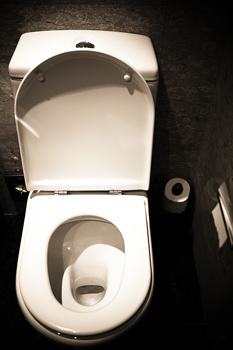How to Repair a Toilet
If you are a homeowner or landlord, learning how to repair a toilet yourself lets you save considerable money on toilet repairs. With a plunger or two and a screwdriver set, you have all you need to handle most toilet plumbing concerns. Commodes aren’t so complicated that you need a professional, most of the time.
Inspecting a Toilet
First, learn what is affecting your toilet. Remove the toilet lid and start to investigate. Start by inspecting the “ball cock”, which is the valve attached to the floating apparatus in the toilet tank. This should look like a plastic ball on the end of a long rod of some sort.
When inspecting the ball cock, check to see whether water is leaking from this valve. If so, then the ball cock needs to be either cleaned or replaced. Clean it first and, if this doesn’t work, replace this device.
Check the Tank Flap
The tank flap is a rubber cone which you can find in the bottom of the tank, fitting into the tank hole. Push on the tank flap and see whether this stop water from running. If so, then the tank flap isn’t covering the hole entirely and needs to be replaced. Take this piece off the toilet to the hardware store, to make certain you buy the right size.
Toilet Repairs – Turn off the Water
Once you have made your inspection and it’s time to make toilet repairs, turn the water flow off. There should be a metal twist valve on the piping between the toilet and the wall. Flush the toilet to remove as much water as possible from the commode.
Tank Flap Toilet Repairs

How to Repair a Toilet
As mentioned before, take the tank flap off the toilet assembly. This should be easy to remove. Use the broken flap to size the replacement, then replace with relative ease. Once finished, turn the water flow back on, replace the toilet lid and you have made repairs on your toilet.
Ball Cock Diaphragm Toilet Repairs
The ball-cock diaphragm is a little harder to replace than the tank flap, but it’s not that hard. Take the cover off the ball cock, then remove the screws that hold down the top plate of the device. You’ll need a screwdriver to perform this step.
Note that the float-control arm may be spring-loaded, so be careful when removing, to see essential parts don’t fall off and get lost.
Removing the Toilet Diaphragm
Next, remove the toilet diaphragm from the toilet, taking careful note to remember which side is the “up” side. Inspect the diaphragm to see whether there’s an obvious reason it’s broken, such as a small household objects or gravel lodged into the device.
After inspecting the toilet diaphragm, decide whether to clean or replace it. If cleaning doesn’t work, you’ll have to replace. All you have to do is to place the diaphragm where the old one sat, then screw in the top plate. Turn the water flow back on and you’re ready to go.
Repairing a Toilet
These are the basic steps to learning how to repair a toilet, but these tend to be the most common problems affecting a toilet. If repairs on the toilet system itself don’t work, you most likely have problems with plumbing in the wall and it’s time to call a plumber.
